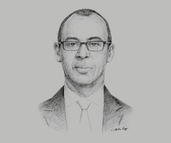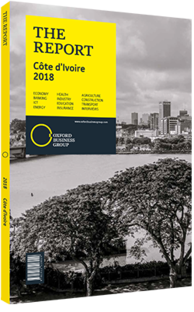Thierry Tanoh, Minister of Petroleum, Energy and Renewable Energy Development: Interview

Interview: Thierry Tanoh
What major projects will help double Côte d’Ivoire’s power capacity by 2020, and what role will renewable energy play in this process?
THIERRY TANOH: Current development projects on par with the Ivorian Electricity Production Company and Azito thermal power plants should increase our capacity by about 650 MW. Other projects include the Songon gas-to-power project and the San Pédro clean coal thermal power plant, which will add 375 MW and 700 MW, respectively. With regards to renewable sources of energy, the Soubre hydropower plant has been operational since September 2017, and has added a further 275 MW of capacity. Two additional hydroelectric projects of between 100 and 150 MW will be developed over the next four years. With just these projects alone, we are already on track to reach the government’s target of doubling the country’s total energy production to 4000 MW by 2020.
However, several new solar and biomass projects are also in the pipeline , as renewable sources are increasingly gaining traction. At the forefront is SIFCA’s biomass project. The construction of this 46-MW power plant will be the first to use agricultural waste (palm) for the production of energy. Tenders for two additional biomass projects – a 25-MW cotton project in Boundiali and a 20-MW-capacity cacao plant in Gagnoa – should also come to a conclusion in the near future.
Indeed, our energy production capacity is closely aligned with our level of economic growth, yet the export of energy offers great potential as many of our neighbours – such as Mali, Guinea, Burkina Faso, Niger, Liberia and Sierra Leone – have growing needs. We currently export 15% of our production and hope to increase our exports in the medium term, as we seek to strengthen regional integration.
How will liberalisation impact the sector?
TANOH: There are several possible scenarios in this regard. Whether we will separate production, transport, and distribution, or allow operators to access two of sectors, is yet to be settled. Regardless, the underlining objective remains to improve the quality of service and overall performance of the sector, while improving its financial position. However, we must not forget that the sector has a public service responsibility to fulfil.
As we know, the main challenge facing the sector is providing universal access to energy,particularly to regions where supplying power can be costly – such as low-density areas. In this context, off-grid solutions – such as solar energy – have become attractive alternatives, as new technologies have become more cost competitive, and allow for remote billing and maintenance. In turn, this will reduce the pressure on the current public network and will enable its sustainable development. However, despite recent and ongoing technological advancements, energy storage is still an obstacle, as prices remain prohibitive.
What potential does Côte d’Ivoire’s basin hold?
TANOH: Given our 400 km of coastline and significant hydrocarbons prospects, for the last several years the government has initiated important measures to harness this potential in an effort to make the sector a pillar of the country’s economic growth.
With four functioning blocks, including eight fields, Côte d’Ivoire’s sedimentary basin produces approximately 40,000 barrels per day of crude oil and 275m standard cu feet per day of natural gas. With all natural gas production going towards local energy generation, Côte d’Ivoire can be considered a captive market for gas, since current and future energy needs are expected to continue their upward trend.
In the last five years, we have successfully signed 27 power-sharing agreements, including those in ultradeep off shore fields, and have effectively ordered numerous seismic surveys and 17 exploration drilling activities, with seven indications of hydrocarbons discoveries, some of which remain under evaluation.
You have reached the limit of premium articles you can view for free.
Choose from the options below to purchase print or digital editions of our Reports. You can also purchase a website subscription giving you unlimited access to all of our Reports online for 12 months.
If you have already purchased this Report or have a website subscription, please login to continue.

